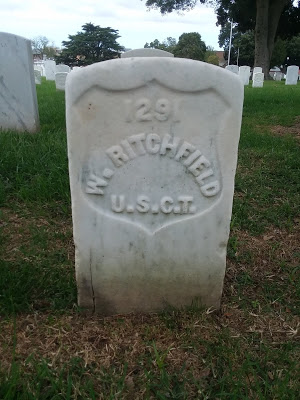
Courtesy of the Maryland Historical Society
By the time the Battle of New Market Heights occurred, the 4th United States Colored Troops (USCI) had already endured enemy fire several times. Their baptism in combat came on June 15, 1864, in the Army of the Potomac’s initial Union attacks on Petersburg. As part of Gen. Edward Hincks’ Division of the XVIII Corps, Army of the James, the 4thUSCI ran into opposition along the City Point Road as it marched toward Petersburg.

The 4th’s sergeant major, Christian A. Fleetwood, recorded his thoughts on June 15 in his pocket diary. Of the morning’s scrap at Baylor’s Farm, Fleetwood noted, “Up at break of dawn and under way . . . went into action early charged out of woods. Cut up badly Regt. Broke and retreated Fired into by 5th Mass. [Colored Cavalry]. Last Regt charged with 22nd [USCI]-Took the [Confederate] Battery.”
After securing the prized guns, Hincks’ Division moved on toward the Dimmock Line defending the Cockade City. Fleetwood again recorded the events: “Lay under their fire all balance of the day advancing by degree in line about 7 P.M. Final charge made Seven guns taken by our Regt. Our loss pretty heavy.” It is unknown whether Fleetwood’s 4thUSCI comrade and fellow Baltimorean, Pvt. William Richfield, received his wound at Baylor’s Farm or during the attacks on the Dimmock Line, but it was significant enough to need treatment at a Union general hospital. Richfield’s June 15 wound would not be his last.
Like so many United States Colored Troops soldiers, unfortunately, not much is known about William Richfield’s life before he enlisted in the 4thUSCI. He does appear on a July 1863 draft registration for Baltimore’s 13th Ward. Apparently, Richfield lived at 40 Hill Street. He gave his age as 22 as of July 1, 1863, and was a married man. The vague label of laborer notes Richfield’s occupation. Although Richfield’s Compiled Military Service Record states that he was a free man of color before the war, a search produced no hits in the 1850 and 1860 censuses.
Fortunately, Richfield’s service records do give some additional information on the man. Interestingly, his service record age is three years advanced from what the draft board noted although taken at approximately the same time. Richfield is described as five feet, eight inches tall, and having a “black” complexion. “Laborer,” again, was his stated occupation. He enlisted in his hometown of Baltimore on July 21, 1863, and assigned to Company B. In addition, it also appears that Richfield performed additional daily duty as a drummer for the 4thUSCI.
Richfield likely endured additional enemy fire in the trenches around Petersburg during the summer of 1864. However, all that came before paled in comparison to the combat faced on September 29, 1864, at New Market Heights. The 4th USCI led the charge early that morning through the mist, and in the written words of Fleetwood’s diary, “got used up.” During the severe fighting, Richfield received a second wounding in his service. Removed from the New Market Heights battlefield, Richfield received transport for medical treatment.
It is unknown if Richfield first received medical aid locally at either the Point of Rocks or City Point hospitals, but eventually, he was either treated at or on the way to the general hospital at Fort Monroe when he died from his wound or wounds on October 5, 1864, aboard the steamer Thomas Powell (shown below). Richfield’s service records indicate he left no personal effects. However, he apparently did leave a wife as a widow, and possibly children, too.

Steamship “Thomas Powell” courtesy of The J. Paul Getty Museum
Today, Pvt. William Richfield rests in grave number 1291 in the Hampton National Cemetery. Although his headstone misspells his last name, the Battle of New Market Heights Memorial and Education Association recognizes the sacrifice of his life in service to the United States. Hopefully by sharing his story with the public we can give him a measure of immortality that he so truly deserves. Rest in peace, soldier.

